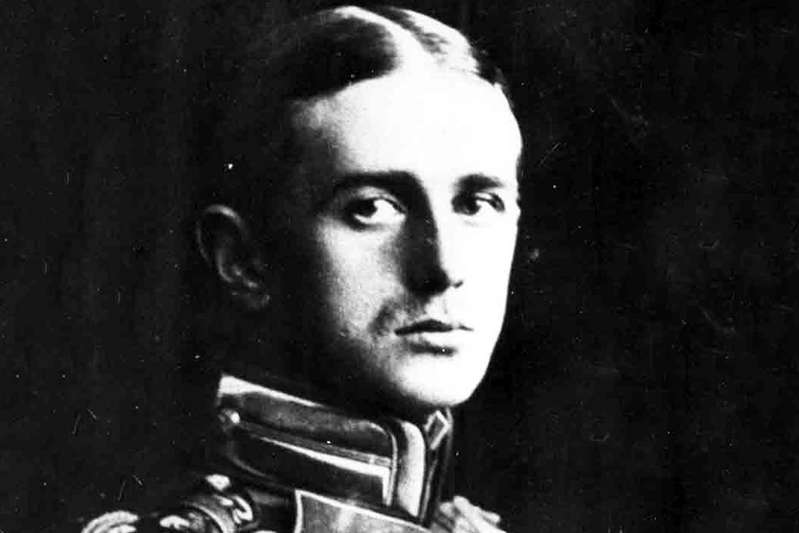
Jan Nagórski, one of Polish pioneers of aviation, the first guy to fly a plane in the Arctic Here in a Russian WWI uniform
Specialists of the Russian Geographical Society (RGO) and military researchers reconstructed the flight route of the first polar pilot of Russia, Yan Nagursky, who in 1914 searched for the missing expedition of Georgy Sedov and other polar explorers in the Novaya Zemlya region. Two Mi-8 helicopters with participants in the reconstruction flew past Cape Borisov, the Admiralty Peninsula, Arkhangelsk Bay and Pankratyev Island. 107 years ago, it was this route on the French biplane Farman MF.11 for the first time passed by Lieutenant Nagursky, who became the pioneer of Arctic flights. The story of the legendary pilot was recalled by Lenta.ru.
1955 year. The famous Polish traveler and author of books on polar exploration, Czeslaw Centkevich, gives a lecture in a crowded hall – and at some point starts talking about the heroes of the Arctic. Among other things, Tsentkevich mentions the Russian pilot Jan Nagursky, “a forgotten aviation pioneer who died in 1917”. At this moment, a middle-aged man rises in the hall, who says: “Well, firstly, I am not quite Russian, and secondly, I have not died at all.” The lecturer was speechless, and the audience stared in amazement at the man who really was Jan Nagursky – the pioneer of Arctic flights.
***
Jan Nagursky was born on February 8, 1988 in the city of Wloclawek in the Warsaw province of the Kingdom of Poland, which at the end of the 19th century was part of the Russian Empire. His father was a simple miller, and the funds in a poor family were barely enough for the boy to graduate from the sixth grade of the gymnasium.
At the age of 17, Nagursky passed the exam and became a teacher in a rural school, and a year later he was admitted to the Odessa cadet infantry school. After graduating in 1909, the young man went to serve in the 23rd Siberian Rifle Regiment in Khabarovsk. After a year of service, Yang decided to continue his education, applied to the St. Petersburg Higher Marine Engineering School and entered there.
In 1911, Nagursky became a cadet of the Imperial All-Russian Aero Club, where he met Peter Nesterov, the founder of aerobatics. Soon, Yan, as a capable pilot, was taken to the Gatchina Officer Aeronautical School: in 1913 he received the rank of a military pilot, while defending his diploma of naval engineer.
A year later, Lieutenant Nagursky was summoned by the head of the Main Hydrographic Directorate, Mikhail Zhdanko. At that time, the management, on command from the Naval Ministry, was supposed to start searching for three polar Russian expeditions from which there was no news – Vladimir Rusanov, Georgy Sedov and Georgy Brusilov. Zhdanko challenged Nagursky to find out if airplanes could be used to conduct searches in the Arctic.
The road beyond the Arctic circle
Meanwhile, officer Nagursky understood that he would have to personally check his words, but there was simply no Russian equipment for flying in the Arctic at that time. Therefore, the lieutenant was sent to France, to the Farman plant to buy a Farman MF.11 biplane. The plane with floats for taking off from the water and landing on it was capable of carrying a load of 300 kilograms and a speed of up to 100 kilometers per hour.
The fuel supply on board the Farman MF.11 was enough for five to six hours of flight
Nagursky wanted to subscribe from France and a local mechanic. But the French experts, having learned that the lieutenant was going to fly to the Arctic, refused. After conducting about 20 test flights on the Farman MF.11, Nagursky took the plane packed in boxes to Russia.
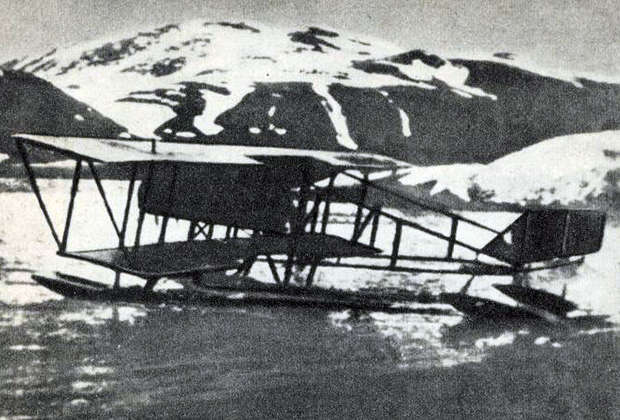
Seaplane of Jan Nagursky Farman MF.11 in Krestovaya Bay on Novaya Zemlya. Photo: Wikipedia
On August 1, 1914, on the Eclipse ship, Nagursky, along with the equipment, arrived in Aleksandrovsk-on-Murman (now the city of Polyarny). There the plane was reloaded onto the steamer “Pechora”, and Yan was joined by an aircraft technician – a sailor from Sevastopol Yevgeny Kuznetsov, who had previously worked with airplanes. The expedition was led by Captain 1st Rank Iskhak Islyamov.
He set for Nagursky the task of examining from the air the area of the coast of Novaya Zemlya from Krestovaya Bay to the Pankratyev Peninsula
On August 16, 1914, the Pechora steamer reached Krestovaya Bay, but it could no longer move on because of the ice. Then Nagursky and the aircraft technician Kuznetsov began to assemble the Farman MF.11 at almost zero air temperature. In these harsh conditions, the assembly of the aircraft took two days.
“The plane barely climbed over the ice”
On the morning of August 21, 1914, Nagursky took off for the first time, made several laps and splashed down: the flight was successful. Then, so as not to waste time, he took on board a supply of food for ten days, a rifle and skis. At 16:30, the lieutenant, together with the aircraft technician Kuznetsov, took to the air again and went in search of polar expeditions.
From the memoirs of Jan Nagursky:
“The heavily laden plane barely climbed over the ice, but then began to quickly gain altitude; more and more beautiful views opened up before us. To the right was an island with ridges of peaked ridges and glaciers descending along them, to the left – a white ocean, on which in some places dark spots of open water could be seen.
All of them sparkled, as if sprinkled with millions of diamonds, in the rays of the setting sun. The knowledge that I was the first person to take off on an airplane in this harsh land of eternal winter filled with joy and anxiety, made it difficult to concentrate. “
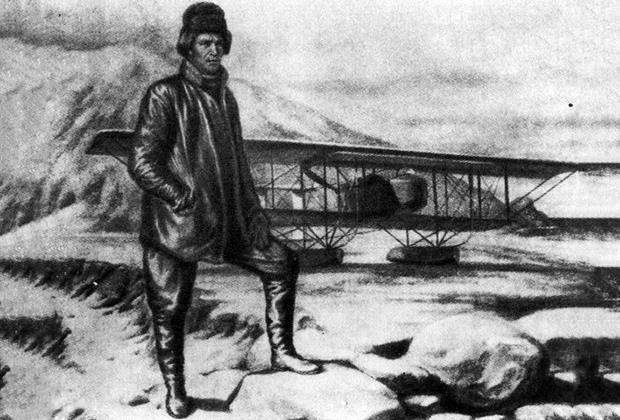
Yan Nagursky at the plane in the Arctic. Image: GoArctic
Nagursky and Kuznetsov were in the air for 4 hours and 20 minutes: during this time they covered a distance of 450 kilometers. The first Arctic flight in world history ended successfully.
Dreams of the North Pole
In total, during the polar expedition, Yan Nagursky made five long reconnaissance flights along the western coast of Novaya Zemlya and near Franz Josef Land. The pilot failed to find traces of the disappeared polar expeditions.
But Lieutenant Nagursky completed another, no less important task: he proved the possibility of using aviation in the Arctic. He also pioneered Arctic ice exploration. In October 1914, Jan Nagursky prepared a report on the results of his participation in the expedition and supplemented it with the project of the first ever air flight to the North Pole.
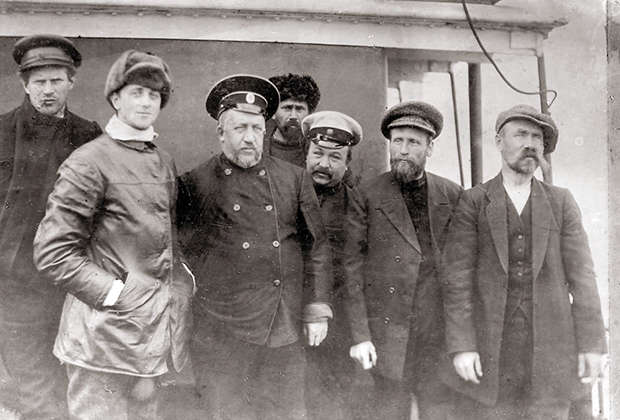
Yan Nagursky (second from left) aboard the steamer “Pechora”, returning in September 1914 from Novaya Zemlya to the mainland. Photo: Yan Nagursky's family archive
Nicholas II appreciated the report of Nagursky and awarded the pilot with the Order of St. Anna, 3rd degree. It is likely that the lieutenant would have performed many more feats beyond the Arctic Circle, but because of the First World War, the development of Arctic aviation was suspended.
As a result, Nagursky's plan for a flight to the North Pole in 1937 was implemented by the hero of the Soviet Union Valery Chkalov. The ANT-25 aircraft under his command made the first non-stop flight across the North Pole from Moscow to American Vancouver.
Living in secrets
After the Arctic, Yan Nagursky became the commander of the Baltic Fleet aviation division and continued his experiments in the sky. It was he who for the first time managed to perform the so-called Nesterov loop on a seaplane.
He also distinguished himself in battles in the Baltic and was awarded two orders – but at the same time there was a rumor that the pioneer of Arctic flights died
The fact is that in 1917, during one of the air battles over the Baltic Sea, Jan Nagursky's plane was knocked out, but he, together with the mechanic, managed to jump out of the car in life jackets. They spent two hours in the water, after which they were lucky in the form of a submarine, which brought both of them to Riga.
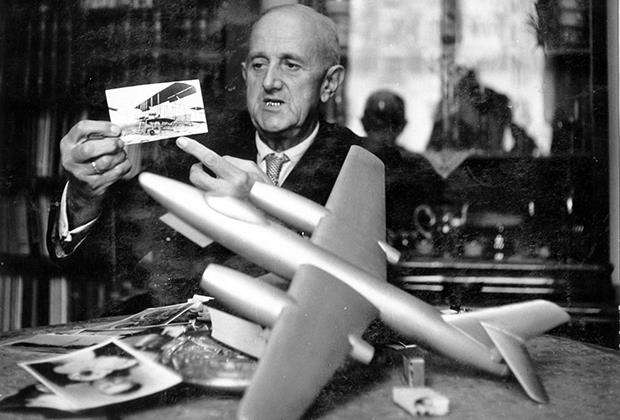
Jan Nagursky with photo Farman MF.11. Photo: Bernard Koszewski / Jan Nagursky Family Archive
But it so happened that many learned about the destroyed plane of Nagursky, but the news that the legendary pilot was rescued went unnoticed. Hence the rumor about his death began. However, in the same 1917, there were other rumors about the fate of Nagursky.
It was rumored that the pilot was not shot down at all, but suspended from flights due to suspicions of espionage in favor of Germany.
Perhaps the reason for such conversations was the fact that the aviator spent several months in the rear without a post. And in September, the Baltic Fleet seaplane congress, for unknown reasons, demanded that Nagursky “leave service in the Naval Aviation.” But the Bolsheviks appreciated the experience and knowledge of the pilot: in December 1917, he got a job in the test department of the Naval Aviation Administration.
Down to earth
Nagursky did not stay in the new place for long: in January 1918, he took out a two-month leave for health reasons and went to Poland, but never returned. Many years later, Nagursky claimed that he simply could not get to Petrograd.
However, according to some reports, the pilot simply decided for himself that he would not cooperate with the Bolsheviks – but he would not fight against them either.
Therefore, once in Poland, Nagursky hid his officer rank and experience as a military pilot, thanks to which he was able to avoid being drafted into the army.
Initially, he got a job at a sugar factory, and later worked in Warsaw, where he became an employee of the design bureaus of the sugar and oil industries. Only a few knew that the legendary pilot was alive at that time. Among them, for example, was the famous designer Igor Sikorsky: he invited Nagursky to his place in the USA. And the American pilot Richard Byrd personally came to Nagursky in Poland in the 1920s to learn the secrets of flying in the Arctic.
Jan Nagursky managed to survive the German occupation, and then continued to work in one of the design bureaus already in socialist Poland
He did not even know that in 1947 an ice airfield named after him was opened on the Franz Josef Land archipelago. And who knows how the fate of Nagursky would have developed in the future, if he had not appeared at that very lecture of Cheslav Tsentkevich.
A year after her, Jan Nagursky visited the Soviet Union, where he met with aviation veterans, and on his return to Poland published two books of memoirs. For his services, he received the “Order of the Renaissance of Poland”. The legendary pilot passed away in 1976.

